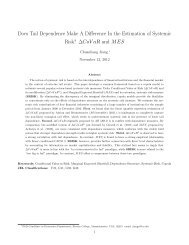A Value-based Pricing Perspective on Value ... - Boston College
A Value-based Pricing Perspective on Value ... - Boston College
A Value-based Pricing Perspective on Value ... - Boston College
Create successful ePaper yourself
Turn your PDF publications into a flip-book with our unique Google optimized e-Paper software.
value in relative terms, as the maximum amount a customer should be willing to pay, assuming<br />
full informati<strong>on</strong> about the product and competitive offerings. Anders<strong>on</strong>, Jain, and Chintagunta<br />
(1993) define value in business markets as the “perceived worth in m<strong>on</strong>etary units of the set of<br />
ec<strong>on</strong>omic, technical, service, and social benefits received by a customer firm in exchange for the<br />
price paid for a product offering, taking into c<strong>on</strong>siderati<strong>on</strong> the available alternative suppliers<br />
offerings and prices” (p. 5). We adopt this perspective that value is perceived by buyers, and<br />
usually is not equivalent to the actual value that buyers may in fact receive. The point of value<br />
communicati<strong>on</strong> is to narrow this gap – between perceived and actual value.<br />
<str<strong>on</strong>g>Value</str<strong>on</strong>g> communicati<strong>on</strong> works to the extent that your product or service creates value that<br />
is not otherwise obvious to potential buyers but is nevertheless important to them. There are<br />
many reas<strong>on</strong>s why your value might not be obvious. The less experience a customer has in a<br />
market, the more innovative a product’s benefits, and the more separated the purchaser is from<br />
the actual user; the more likely it is that the value of product or service differentiati<strong>on</strong> will be<br />
unrecognized or underappreciated. For example, without a planned communicati<strong>on</strong> from the<br />
seller, a business buyer may not have c<strong>on</strong>sidered that your nearby distributi<strong>on</strong> locati<strong>on</strong> and<br />
resulting short time to delivery, could reduce or eliminate the need to hold inventories.<br />
Moreover, if the buyer is unsophisticated, he may not have recognized the high cost of holding<br />
inventories for your technology product for which industry prices decline <strong>on</strong> average by 15% per<br />
year. In this case, explaining how quick delivery could reduce inventory costs by more than your<br />
price premium could motivate a purchase that would not otherwise have seemed prudent. .<br />
Still, even a well-documented case for the value of your differentiati<strong>on</strong> will not have an<br />
effect unless the buyers are motivated to listen. <str<strong>on</strong>g>Value</str<strong>on</strong>g> communicati<strong>on</strong> is effective to the extent<br />
that buyers see the price as ec<strong>on</strong>omically important. 1 The price is ec<strong>on</strong>omically important when<br />
the buyer is committed to getting “a good deal” or “the most for my m<strong>on</strong>ey” as opposed simply<br />
to making a purchase that meets the need. There are five reas<strong>on</strong>s why people often make<br />
purchases without a str<strong>on</strong>g motivati<strong>on</strong> to minimize cost of meeting their need.<br />
• The Expenditure Effect—Some expenditures are just too small to justify serious thought<br />
or effort to find the ec<strong>on</strong>omically best deal, rather than simply to find a brand that meets<br />
the need. In business markets, they are purchases too small to justify a purchasing<br />
agent’s time. In c<strong>on</strong>sumer markets, they are called “impulse” purchases.<br />
• The Shared Cost Effect---Some expenditures involve spending other people’s m<strong>on</strong>ey, in<br />
whole or in part. So l<strong>on</strong>g as travel expenses are within a business pers<strong>on</strong>’s expense<br />
budget, for example, there is not much incentive to look for the best deal.<br />
• The Switching Cost Effect—Some expenditures involve making a supplier-specific<br />
investment before being able to gain maximum value. A business might have to train its<br />
employees <strong>on</strong> the use of a particular software package. A c<strong>on</strong>sumer might have to<br />
educate her lawyer, child-care provider, and hairdresser <strong>on</strong> her needs and expectati<strong>on</strong>s<br />
before they can fully meet her needs. Unless these customers get some indicati<strong>on</strong> that a<br />
price difference between brands exceeds this hurdle, they will repeat buy from the same<br />
supplier without evaluating other brands.<br />
4

















